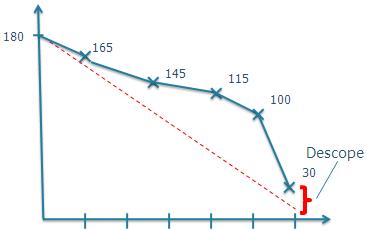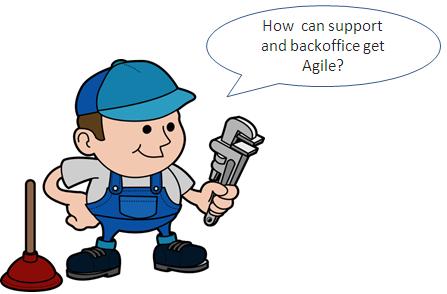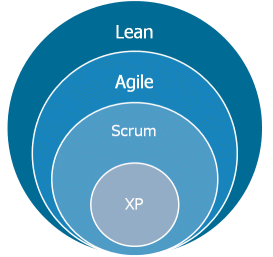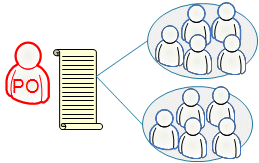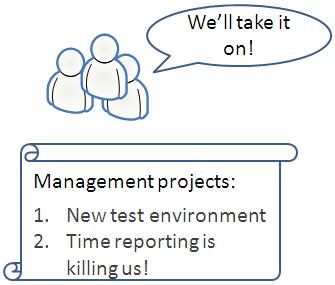Here are the slides from my session "Multi-team sprint planning" from Scrum Gathering 2008 in Stockholm. Here is all the other material from the Scrum Gathering. Interesting stuff!
Continue readingCrisp's BlogPage 32
from the Crisp Consultants
Bootstrapping Scrum – Lessons learned helping companies get started
Here are the slides from my session "Bootstrapping Scrum – Lessons learned helping companies get started" from Scrum Gathering 2008 in Stockholm. I used the same slides at the Scan-Agile conference in Helsinki Oct 29. Here is all the other material from the Scrum Gathering. Interesting stuff!
Continue readingWhy Kanban can tell you more than Scrum
Have you experienced a burndown similar to this?
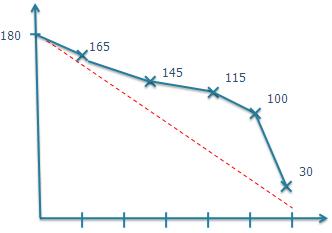
More than once?
Let me show how Kanban can help both team and managers to spot the underlying problem before it is too late.
Continue readingTrust me – promises and lies in agile projects
Yesterday I was at the "Agile i Sverige" conference in Stockholm and did a keynote called "Lita på mig – löften och lögner i agila project". In English that would be "Trust me – promises and lies in agile projects". Here are the slides. The slides are in Swedish (although I ended up doing the
Continue readingQualities Attributed to the Architecture
Functional requirements describe how a system delivers value. However, the quality attributes of those functions will make or break it. For example, if your functional requirment is about something that takes you from one city to another, I have a car to sell. Really cheap, for that matter.
Every system has an architecture. It may be elegant or it may be ugly. It may be described or it may be unknown. But it is.
Architecture is what determines the qualities that the system delivers. Is it fast? Is it secure? Can it be extended? Does it scale?
The qualities you strive for should determine the design of the architecture – not the other way around.
Continue readingAnalys av alliansens FRA-uppgöresle, punkt 11
I Alliansens uppgörelse om FRA-lagen från 25:e september finns 15 punkter beskrivna. Punkt 11 lyder: En underrättelseskyldighet till enskild införs. I min naivitet trodde jag att det betydde att en individ som felaktigt blev avlyssnad skulle få veta det. Helt fel, visar det sig, enligt interna dokument innifrån alliansen, för ansvaret ligger på oss individer
Continue readingParprogrammering – är du tveksam?
Innan jag började med parprogrammering för några år sedan var jag en skeptiker. Numera vet jag att det fungerar och varför. Får jag välja själv, programmerar jag inte på något annat sätt.
När en kollega nyligen efterlyste argument för parprogrammering (då han mött en motsträvig organisation) fick jag konkretisera min tankar kring varför det fungerar och vilka vinster man når.
Continue readingAgile for support and operations in 5 min
Scrum does not fit well into the fast moving world of support. There is no Sprint committment, there is just continuous work.
But support teams can go Agile. The solutions is spelled Kanban. I have coached two support teams adopting Kanban and attached is a visual representation in how we did it.
"It really helps us visualize our projects and situation"
– Team member
"The first useful thing I can bring with me"
– Team member
How support can go Agile in 5 min
This is not the only way to do it and it is certainly not the end station :). It was just the way that helped our teams to "get going" instead of talking about it.
— mattias.skarin(at)crisp.se
My favourite top 5 Agile team rules
Building something common out of high performing individuals is not always easy. Here are my favourite five Agile team rules:
- Best idea prevales! "No" – is allowed, if you can come up with something better
- Steady progress beats tripping and falling over
- Bad news first
- In order to lead an army, you have to be able to lead a group. In order to lead a group, you have to be able to lead yourself
- Is it better to be right or to be helpful?
The day I know I have succeeded with Agile? -The day I am out surfing 🙂
Continue readingHow do support and operations get Agile?
As part of development teams and as project managers, I have worked with a number of support departments. They face similar issues:
- "We can’t promise project completion – we are interrupt driven"!
- I want coworkers to take a bigger responsibility, but how?
- How can we too get Agile?
The solution is spelled Kanban Scrum (or just "Kanban"). Currently I am coaching two teams in support/operations to tackle above issues. Being one month into this, I see both teams do great progress. I will get back to tell how we do it. Stay tuned.
Continue readingAnalys av alliansens FRA-uppgöresle, punkt 8
I Alliansens uppgörelse om FRA-lagen från 25:e september finns 15 punkter beskrivna. Punkt 8 lyder: Sökbegrepp som är direkt hänförliga till en viss fysisk person får inte användas utan särskilt tillstånd. Vad betyder detta? Jag menar att det inte betyder något alls. För det första så måste alla sökningar föregås av ett särskilt tillstånd från
Continue readingScrum is like chess..
"Scrum is like chess, simple rules but hard to play"
– Who else but my collegue Henrik 🙂
Continue readingPerspective of Retrospective
Scrum received some criticism today in Computer Sweden. The article featured an interview of Ken Schwaber and our guy Henrik Kniberg. Tobias Fors from Citerus was giving the comment that Scrum lacked support for retrospective. I am not sure if he was quoted correctly.
I am in the belief that Scrum has three roles, three artefacts and three meetings. Of the latter, there is one you should never skip.
Continue readingIntroduction to Lean Software Development
Here are the slides from my presentation "Vadå Lean Software Development" (Introduction to Lean Software Development) at HiQ on Oct 13. Note – the picture above (the last slide in my deck) can easily be misinterpreted when used out of context. It is not meant to imply that XP is a subset of Scrum, or
Continue readingMulti-team sprint planning
Here are the slides from my session Multi-team sprint planning. The session took place at the Scrum Forum meeting in Aarhus on Oct 1, in conjunction with the JAOO 2008 conference.
Continue readingWhat’s hard about being an agile developer?
"Simple" is a word often used in agile software development. Terms like YAGNI and "do the simplest thing that can possibly work". It is easy to forget, however, that Simple is often Hard! So what’s hard about becoming an agile software developer, where are the bumps in the ride? In this talk I went through
Continue readingNFI Från krav till system .- Lean software and scrum applied
Here you can find my slides from NFI’s conference "Från krav till system" ("From requirement to complete system"). It is the story of two destinies and how they overcame using Lean and Scrum.
Continue readingDärför får jag ont i magen av DSL
Martin Fowler, mångas favoritförfattare inom mjukvarubranschen (mig inkluderad), håller på att skriva en bok om DSL (Domain Specific Languages) som ska bli färdig 2010. Det borde väcka min nyfikenhet, men jag får bara ont i magen. Teknostress? Kanske det, men det är något med DSL som inte är nyttigt. Tyvärr har jag har inte kunnat
Continue readingRIP Good Times PowerPoint slides från Sequoia Capital
En av Silicon Valleys mest respekterade venture capital företag, Sequoia Capital, hade i veckan ett all-hands möte med de som driver firmans investeringar. De 56 PowerPoint slidsen beskriver i detalj hur illa den amerikanska ekonomin mår, och presentationen kallas av TechCrunch för Presentation of Doom. Rätt intressant om man vill följa hur det går i
Continue readingDependency Injection i Scala
Jonas Bonér har bloggat om Dependency Injection i Scala. Han presenterar tre olika sätt att göra det på, och hans favorit är rätt elegant. Ingen XML, och helt statiskt typat, men det känns ändå som lite av ett hack. Att ha en trait innanför en annan trait? Hm… som lite av de hack jag såg
Continue readingScala klättrar snabbt på Tiobes lista – nu före Groovy!
Senaste listan på programmeringsspråk från Tiobe bjuder på en snabb klättring på ca 10 platser för Scala, som nu återfinns på plats 37, strax före Groovy på plats 39. Mina nyhetskanaler är lite skeva, men jag tycker ändå att det är rätt tyst runt Groovy. Ett halvintressant inlägg om Grails är det enda jag sett
Continue readingEmail eats your day
Email has reached into the everyday life of almost every profession. While I have been using it since the 80’s, its usage has accelerated enough to make it an issue even to us who are used to it since long.
There is research that shows that we use a lot of time reading email. It may be waste.
Here is a suggested personal policy for handling you email.
Continue readingDealing with persistent impediments
Not all impediments are easily fixed. They can be structural by nature. Lack of space, bad air or organization legacy is not always an easy fix. So what to do? Do you:
|
 |
Usability will cost you money, ignore or score
Anna Forss writes under the subject "What do you test" some interesting and classical observations on how users cope with systems that has bad usability.
I will elaborate some on the comment I made at her blog.
As a product owner, you should be highly aware that usability will cost you money, regardless if you ignore it or not.
Continue reading$22 500 för SpringSource Enterprise support?
Ryan de Laplante kollade upp med SpringSource, företaget där de flesta utvecklarna av Spring kommer ifrån, och frågade vad en enterprise licens skulle kosta. Han hade en del problem som han inte fick svar på via de vanliga Spring Forumena. Svaret blev den nätta summan US$22,500. Det ska bli intressant att se hur Rod Johnson
Continue readingNej, FRA debatten är inte över
Många tidningar har basunerat ut påståendet att FRA debatten skulle vara över, eftersom det verkar som om alla inom alliansen var överens om ett antal ändringar. Tack och lov verkar Socialdemokraterna inte köpa det hela. Med lite tur så river de trots allt upp det hela när de vinner nästa val. För det lär de
Continue readingCascading – MapReduce without the complexity
Just bumped into Cascading, which is an open source (GPL 3) framework "for defining and executing complex and fault tolerant data processing workflows on a Hadoop cluster". Hadoop is, I’m sure you all know, an implementation of MapReduce which is at the core of how Google does its processing. Anyway, the Cascading API "lets the
Continue readingWhat is SpringSource doing with its license?
It appears as if SpringSource, the company doing most of the development of Spring, is doing an ExtJS, i.e. changing the license of its product to force users into paying for it, or its support. Lots of people are writing about this, such as Alessandro Santini at JavaLobby. Does anyone have any enlightening comments? Regardless,
Continue readingSwedish hospital goes lean
This article on DN (major Swedish newspaper) caught my attention this morning:
The title of the article is "Waiting times at Huddinge halved with new process".
We spend a lot of time helping IT companies understand how to use Lean principles to increase the speed and quality of their product development. It’s interesting to see how the same techniques are applied in totally different domains – in this case the intensive care unit at a hospital.
Continue readingWoohoo: Mixed Scala and Java projects in Eclipse
A few days ago Scala 2.7.2 RC2 was released. One of the new features is mixed Java and Scala support in both the compiler and the Eclipse plugin. I decided to try it out. Installation was very simple. I then set off creating a simplistic Java class side by side with the Scala object, in
Continue reading

